
TOPIC:Kingdom Animalia
The word 'animal' is derived from the Latin wordanimaliswhich means 'having breath'. The Kingdom Animalia is characterized by eukaryotic and heterotrophic organisms. They are multicellular and lack cell wall. They depend directly or indirectly of plants for their food. Food is ingested and digested in their internal cavity and food reserves are stored as glycogen or fat. Nutrition is holozoic, i.e., by ingestion of food. Animals follow a definite growth pattern, the adults have a definite shape and size. Higher forms of animals exhibitwell developed sensory and neuromotor mechanism. Most of the organisms are capable of locomotion. Reproduction is by copulation of male and female which is followed bydevelopment in embryonic stages.
General and Distinctive Features of the Kingdom Animalia
Explain general and distinctive features of the kingdom animalia
Distinguishing characteristics of the Kingdom Animalia include:
- Cell type - Eukaryotes
- No cell wall
- Nutrion - Heterotrophic, ingestion
- Body form - Muticellular,(invertebrate/ vertebrate)
- Nervous system - primitive to advanced sensory systems
- Reproduction - All sexual, some also asexual
- Locomotion - Ability to move at some point and time throughlife cycle
General characteristics of the Kingdom Animalia are as follows:
- Animals are eukaryotic, multicellular and heterotrophic organisms.
- They have multiple cells with mitochondria and they depend on other organisms for food.
- Habitat - Most of the animals inhabit seas, fewer are seen in fresh water and even fewer on land.
- There are around 9 to 10 million animal species that inhabit the earth. Only 800,000 species are identified.
- Biologists recognize 36 phyla in the animals kingdom.
- Size - The sizes of animals ranges from a few celled organism like the mesozoans to animals weighing many tons like the blue whale.
- Animal bodies - Bodies of animals are made of cells organized into tissues which perform specific functions. in most animals tissue are organized into complex organs, which form organ systems.
- Cell structure - The animal cell contains organelles like the nucleus, mitochondria, Golgi complex, ribosomes, endoplasmic reticulum, lysosomes, vacuoles, centrioles, cytoskeleton.
- Animals are made up of many organ systems, that aids in performing specific functions that are necessary for the survival of the organism.
- Organ systems are skeletal system, muscular system, digestive system, respiratory system, circulatory system, excretory system, reproductive system, immune system and the endocrine system.
- Body symmetry - Most of the animals are bilaterally symmetrical, while primitive animals are asymmetrical and cnidarians and echinoderms are radially symmetrical.
- Locomotion - Most animals have the ability to move, they show rapid movement when compared to plants and other organisms.
- Respiration - It is a gaseous exchange of taking in oxygen and giving out carbon dioxide. This process takes place in organs of respiration like the lungs, gills, book gills and book lungs and some animals skin is also used for respiration.
- Digestion - Animals ingest food, and digestion takes place in the internal cavity like the digestive system in animals, in primitive animals vacuoles are for digestion.
- Nervous system - Sensory mechanism and the coordination of the organ systems is carried on by the nervous system. In animals the nervous system comprises of nerve ganglions, or brain, spinal cords and nerves.
- Circulatory system - The distribution of nutrients, exchange of gases and removal of wastes takes place in the circulatory system. This system comprises of the heart, blood vessels and the blood.
- Excretory system - Removal of wastes from kidneys.
- Skeletal system - support and protection is provided by the skeletal system.
- Reproductive system - Most animals reproduce sexually, by the fusion of haploid cells like the eggs and the sperms.
- Glands of the endocrine system help in control and coordination of the body system.
The major Phyla of the Kingdom Animalia
Mention the major phyta of the kingdom animalia
Kingdom Animalia has approximately 36 sub-divisions known as 'phyla'. Each phyla share particular properties structurally and functionally which together separate it from other phyla. Below are the most common phyla classified under traditional biological methodology
- Phylum Porifera- They are primitive organisms, most of them are salt-water sponges. They do not have organs or nerve cells or muscle cells. Approximately, 8,000 species exist today. Example:Sycon, Euspongia, Spongilla.Phylum Coelentrata (Cnidaria)- This group is composed of jelly-fish and other lower aquatic animals. Approximately, 15,000 species exist today.Example:Aurelia, Adamsia.
- Phylum Platyhelminthes- This group consists of flat worms. They inhabit both marine and fresh water habitats and they are mostly endoparasites found in animals. Example:Taenia, Fascicola.
- Phylum Aschelmeinthes- It is a group of round worms, most of them are parasites. This phylum consists of about 80,000 parasitic worms.
- Phylum Annelida- They are present in aquatic, terrestrial and are free-living or parasitic in nature. This phylum comprises of segmented worms. Example: Earthworm, Leech etc.Phylum Arthropoda- This is the largest phylum which consists of insects. There are over 1 million species of insects existing today. Example: Locusts, Butterfly, Scorpion, Prawn.
- Phylum Mollusca- It is the second largest phylum. They are terrestrial and aquatic. Example:Pila, Octopus.
- Phylum Echinodermata- This consists of sea stars and sea urchins. There are about 6,000 species. Example:Asteria,Ophiura.
- Phylum Chordata- Animals of this phylum have a characteristic feature of presence of notochord, a dorsal hollow nerve cord and paired pharyngeal gill slits. Within this phylum advanced group called vertebrates which include fish, amphibians, reptiles, birds and mammals.
Phylum Platyhelminthes
Phylum Platyhelminthes
Etymology:-From the Greekplatyfor flat andhelminthesfor worms,Hence Flat Worms
The General and Distinctive Features of the Phylum Platyhelminthes
Explain the general and distinctive features of the phylum platyhelminthes
Characteristics of Platyhelminthes include:
- Bilaterally symmetrical.
- Body having 3 layers of tissues with organs and organelles.
- Body contains no internal cavity.
- Possesses a blind gut (i.e. it has a mouth but no anus)
- Has Protonephridial excretory organs instead of an anus.
- Has normally a nervous system of longitudinal fibres rather than a net.
- Generally dorsoventrally flattened.
- Reproduction mostly sexual as hermaphrodites.
- Mostly they feed on animals and other smaller life forms.
- Some species occur in all major habitats, including many as parasites of other animals.
The Structure of Organism under the Phylum Platyheminthes
Describe the structure of organisms under the phylum latyhelminthes
Platyhelminthes are mostly worm like creatures that are dorsoventrally flattened, meaning they look like a ribbon, this is why they are called names such as Tapeworm, Flatworm, Fluke and Planarian
The Platyhelminthes are a successful phylum with around 25,000 known species divided into four classes. Most Platyhelminthes are parasites on other animals, only the Turbellarians are mostly non-parasitic. A few species are commensalists living in harmony, or mutual benefit with another, normally larger organism. Most species feed on animal material either as parasites or as scavengers, a very few species feed on algae. Although a few of the free living marine and terrestrial species are very beautiful, most species are not particularly attractive to the human mind.
Platyhelminthes live nearly everywhere, on land, in both fresh and marine waters as well as inside other animals. Most of the free living species are marine with only a small number inhabiting fresh water and very few being terrestrial. Parasitic species normally move between different habitats as they change life cycle stages and hosts. A number of parasitic species are of importance to mankind because they infect either our bodies or the bodies of our livestock. A few species can be fatal to humans if not treated, but nearly all species can be treated with modern medicines. Schistosomiasis (Bilharzia) is the most important platyhelminth disease of humans, causing much suffering and some death, over 200 million people are infected with the causative agent in tropical countries.
While they remain fairly morphologically simple the Platyhelminthes show several advance in body structure over the simple radial phyla that came before them. They have a definite congregation of of sensory organs(a few have light sensing organs) and nervous tissues at one end of their body giving them a distinct head and tail. They also have distinct upper and lower (dorsal and ventral) body surfaces. They have a number of organs and even the beginnings of organ systems and a more distinct 3rd layer of cells in their body plan. The evolution of this connective tissue, called parenchyma, the cells of which serve as storage reservoirs as well as protecting the internal organs, is a major step forward toward the more complex body plans of higher animals, such as humans.
However they still no anus, instead they have only a blind ending gut, or no gut at all. Those species with a gut must therefore excrete there digestive waste products through their mouths.
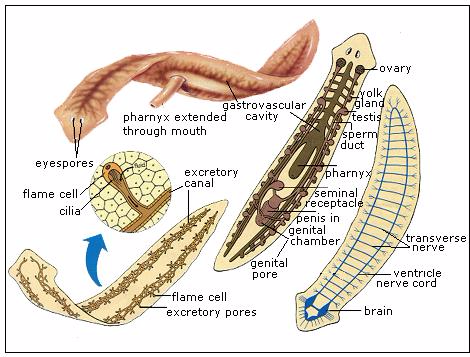
Planarian Anatomy
Phylum Aschelminthes (Nematoda)
General and Distinctive Features of the Phylum Aschelminthes
Explain general and distinctive features of the phylum aschelminthes
Characteristics of Phylum Aschelminthes are:
- Mostly parasitic (in animals and plants), a few free living called as flukes.
- Body is long, cylindrical, fusiform (pointed at both the ends).
- Body wall is composed of cuticle, epidermis and musculature.
- Presence of a false body pseudocoelom not lined by epithelium.
- Digestive system is complete.
- Respiration by simple diffusion.
- Nervous system consists of a nerve ring and many longitudinal nerve cords.
- Only sexual reproduction. Sexes are separate with sexual dimorphism. Males are usually shorter than females
The Structure of Organisms under the Phylum Aschelminthes
Describe the structure of organisms under the phylum aschelminthes
The Phylum Nematoda (roundworms or nematodes) includes harmless, soil-dwelling roundworms (nematodes) that eat decaying organic material or small soil animals. The phylum also includes plant parasites that infect the roots of plants. These parasitic nematodes decrease the productivity of many human crops. The phylum includes several human parasites (see below).
Like the Phylum Platyhelminthes, the Phylum Nematoda consists of bilaterally symmetrical animals that have the organ system level of organization.
The Phylum Nematoda differs from the Phylum Platyhelminthes in two significant ways. First, roundworms have a complete digestive system. This means that there are two opening to the digestive system. The mouth at the anterior ingests or swallows food, and the anus at the posterior releases digestive waste. A complete digestive system is much more efficient than a cul-de-sac gut. The complete digestive system allows continuous processing of food. A roundworm can eat continuously, food digestion can occur continuously, and waste material can be released continuously. Animals with a cul-de-sac gut must wait until a meal has been digested, release digestive waste from the mouth, and only then swallow the next meal.
The second significant difference between the Phylum Nematoda and the Phylum Platyhelminthes is that the roundworms have a fluid filled body cavity. The presence of this structure allows space and cushioning for organs, provides the roundworm with a hydraulic skeleton, and aids in the distribution of food from the digestive tract to the other cells of the worm.
Several human parasites are roundworms. Many people in tropical countries are infected with hookworm. Immature stages of this parasitic worm burrow through the skin, travel through the blood vessels to the lungs, enter the air spaces of the lungs and crawl into the esophagus. The immature stage is then swallowed. The worm attaches to the intestine with hooks and matures into an adult. Fertilized eggs are released with feces, and the zygotes develop into immature stages on soil. When people walk barefoot over the soil, they become infected. The mature hookworm drinks blood and lymph juices. They cause anemia due to blood loss.
The human roundworm is common where human feces is used as plant fertilizer. People ingest eggs when they eat plant material. The immature stages travel through the human body in blood vessels. Mature human roundworms live in the intestine where they produced eggs that are released with feces.
People can become accidentally infected with the trichina worm by eating undercooked port. The muscle of pork may contain immature stages of trichina worm. When people ingest the larval stage, it matures in the intestine where the adult worms reproduced. Immature stages migrate from the intestine to muscle tissue. There the larva forms a cyst. Since humans aren’t generally eaten, the cysts become coated with calcium carbonate. This causes muscle stiffness. We call this condition trichinosis.
The Advantages and Disadvantages of Roundworms
Outline the advantages and disadvantages of roundworms
Roundworm parasitesaffect most species of animals and plants, making them important agricultural pests. There are also several species of roundworms that live in humans, some nasty, some not. Here are a few...
- Trichinella spiralisis alsoa parasite that has been around for a while, since it has probably been responsible for several cultures long-standing dietary laws.Trichinellacan be found around the world, more in temperate zones than the tropics, mostly in various animals that eat meat, from rats to bears. Humans most common exposure comes from pork, and pigs commonly pick it up from eating rats. These worms can live as juveniles in muscle and other tissues while adults occupy support tissues and the lymphatic system. A new host becomes infected by eating tissue containing juveniles. Juveniles become adults and mate in the new hosts intestines, then females bore out of the intestines, which can cause a wide range of serious symptoms, settle someplace and begin to release juveniles, which migrate all over the body, causing damage as they go, until they mostly coil up in muscle tissues and "wait" for the host to be eaten by a new host.
- Hookwormsinfecta variety of mammals, with species in cows, dogs, cats, and others, as well as humans. Hookworms are fairly host-specific - worms of non-human hosts cant live long in a human. You definitely dont want to catch one of the hookworms specific to humans, though. They have a very unusual habit for worms that live in the intestine: instead of living on all of the food around them, they bite through the intestinal lining and live on blood. Serious infections occur when bacteria from the intestines get into the surrounding tissues and/or the blood, and heavy infections can produce enough blood loss to cause anemia. Its no wonder that one genus is called
- Necator,or "killer"! Hookworm eggs pass in feces, and juveniles live for a while in the soil if its nice and wet. The worms get into the next host either by latching on and boring through their skin, or sticking to paws and getting licked off. If they come in through the skin, they get into the blood and migrate to the intestines, usually by way of the lungs, sometimes causing tissue damage as they go.Hookwormsfor non-human hosts that penetrate human skin by mistake can wander under the skin, unable to penetrate further, but the bodys reaction to them can cause a condition sometimes calledcreeping eruption.
- Ascarisis animpressively largeworm, up to 50 centimeters long and about as thick as a pencil, that lives in human intestines, with maybe as much as a quarter of the worlds population infected. They aretaken inas accidentally-swallowed eggs, hatch in the intestine, and the juveniles bore out, get into the blood, wander the body (where they can cause problems), emerge in the lungs, grow there for a while (and possibly cause problems), then migrate up to be swallowed and get back to the intestines again, where they mate. Females find males by touch (its dark in an intestine) and crawl into the males hooked tail for mating; sometimes they mistake the opening of the ducts from the liver or pancreas for a males tail and get caught, blocking the flow of digestive juices. A heavy infection can produce aknot of wormsthat blocks movement of materials through the intestine. Females that cant find males have been known to migrate up or down the canal, reaching thenoseor anus in some cases - quite a surprise for the host! Females lay eggs that pass in feces. The eggs can remain infective in the environment for years, long after that fecal material has been broken down. Dirty hands in the mouth explains why children are the most common hosts for these worms.
- Filarial wormsare a group of roundworms that commonly use biting insects to get juveniles from host to host, then the adults live in the fluid systems - blood or lymph systems - of the final host. There are several filarial worms that infect humans, includingWuchereria,which can block fluid drainage through the lymph system, causing grossswellingof tissues and a form ofelephantiasis.
- Onchocercacausesa disease calledriver blindnesswhen juvenile worms enter and graduallydamagethe eyes (the "river" part is due to the biting fly carriers being tied to rivers for breeding, restricting thegeographical rangeof the disease).
- Heartwormsarefilarial parasites of dogs and cats. The juvenile worms are carried by mosquitos, and the adults settle in the chambers and major vessels of the heart. Heartworms do not generally infect humans.
- Dracunculus medinensis,alsocalled guinea worms, have been known and written about for centuries (although often called "serpents" in modern translations), including passages from Ancient Greek scholars and from the Bible. Adult worms can be as long as a meter, although they are very thin. As adults, they live in the tissues under the skin, usually somewhere at and below the hips, where they may be visible as a white line. After mating, a female produces huge numbers of eggs that hatch inside her and begin to migrate out into the surrounding tissue, often causing an allergic reaction with inflammation and ulceration of the skin (some ancient texts call them the "fiery serpents" from their effects on the skin). When the skin breaks, many many tiny juvenile worms may emerge. An opening remains in the skin through which the female will continue to release young. To continue theirlife cycle, the juvenile worms must get into open water and infect a tiny crustacean; for this reason, worms are most active when the skin is wet.Ancienttreatments, still used in some places, involve cutting a thin slot in a stick, wetting the skin so the worm sticks out, catching the writhing worm in the sticks slot, then winding it slowly out from under the skin. The medical symbol, thecaduceus,of asnakeorsnakeswrapped around a pole,most likelyis taken from one of the few effective devices ancient doctors had, a worm-removal stick (worm, snake; remember, in ancient classification schemes not much distinction was made among long wriggly things). Worms infect the next host whenwater containing infected crustaceans is drunk; the juveniles leave their carriers in the intestine, bore out of the intestine and migrate to their position under the skin. Humans are affected both by their allergic reactions to the released juveniles, infections from bacteria that enter through the broken skin, and worms that stall in deeper tissues, where they may cause serious damage. Because there is a fairly simple preventative measure - physically filtering drinking water -this parasite is very close to being eliminated.
Phylum Annelida
General and Distinctive Features of the Phylum Annelida
Explain general and distrinctive features of the phylum annelida
Characteristics of Annelida:
- Bilaterally symmetrical and vermiform.
- Body has more than two cell layers, tissues and organs.
- Body cavity is a true coelom, often divided by internal septa.
- Body possesses a through gut with mouth and anus.
- Body possesses 3 separate sections, a prosomium, a trunk and a pygidium.
- Has a nervous system with an anterior nerve ring, ganglia and a ventral nerve chord.
- Has a true closed circulatory system.
- Has no true respiratory organs.
- Reproduction normally sexual and gonochoristic or hermaphoditic.
- Feed a wide range of material.
- Live in most environments.
Structure of Organism under the Phylum Annelida (Earthworm)
Describe structure of organism under the phylum annelida (Earthworm)
The Annelida are a medium sized phylum of more than 9,000 species of worms. Most species prefer aquatic environments, but there are also a number of well know terrestrial species. Only a few species of annelids are commonly known to human beings, these include the delightful Rain, Dew or Earthworms that work so hard to make our soils healthy, the Ragworms and Lugworms used by marine fishermen and the much smaller Tubifex or Red worms used by aquarists to feed their fish. In many countries people are still familiar with Medicinal leeches, and people who live closer to nature are naturally more familiar with a much wider range of Annelids than those who live in cities.
Annelids range in size from the Giant Earthworms, of whichMichrochaetus rappi(Michrochaetus michrochaetus) is the largest, this magnificent animal has an average length of 1.36 m (54 ins) and a record breaking specimen has been recorded that measured 6.7 metres (22 ft) in length, it was 2cm (0.8 ins) in diametre. Larger worms have been reported but not scientifically proven. The smallest Annelid known to science isChaetogaster annandalaiwhich is full grown at 0.5 mm (0.02 ins).
Annelids have two main modes of existence, they either live rather quietly in holes or they live more active lives. The basic Annelid body plan is one of a head followed by a long thin body of numerous similar segments ending in a small tail. The head consists of a mouth (prostomium) and sometimes a peristomium, and the tail is more correctly called a pygidium, as it is not really a tail. Annelids are coelomate animals meaning they have a true coelom within their body. They have sets chaetae attached to each body segment, and these can be simple and small as in the Earthworms or complex and varied as in many Polychaetes. The head is often reduced and difficult to distinguish in the hole living species, but may be easily recognised, with eyes and other sensory devices in those species living a more active life.
Annelids are coelomate animals (meaning they have a truecoelom, even if this is reduced secondarily). They normally have long thin bodies composed of a series of identical segments. These segments lie between the head, comprised of a prostomium, a mouth and sometimes a peristomium, and a tail called a pygidium. Growth occurs both laterally, by enlargement of the segments during the juvenile stages, and through the addition of new segments. New segments are produced by the foremost section of the pygidium. In some species they are produced throughout the animals life but in many species production stops once a certain set number of segments has been achieved.
Advantages and Disadvantages of Lumbricus (Earthworm)
Explain advantages and disadvantages of lumbricus (Earthworm)
Despite the amazing and delicate beauty of polychaetes such as the Fan Worms, and the huge (really beyond estimation) economic debt owed by mankind to the Oligochaete Earthworms for their work in soil creation and maintenance many people still fail to appreciate their true wonder and beauty.
The earthworms, of which there are many species, are exceedingly important in soil creation, particularly in temperate areas. Without them, agriculture and perhaps the whole of human society as we know it would never have evolved. Like so much of the unnoticed invertebrate world earthworms are essential to our very existence. In marine environments the numerous species of Polychaetes play a fundamentally important role in the maintenance of food chains and the whole ecological balance of the seas, thus supporting the seemingly endless stocks of fish we like to eat.
One of the strangest ways that humans relate to Annelids is in the hobby of 'Worm Charming'. This involves enticing earthworms from their holes (catching them), originally it was a means of acquiring worms for bait, but now-a-days it is a sport. The world record as far as I know is held by Tom Shufflebotham who charmed 511 worms from their underground hideouts from an area of 3 square metres in only 30 minutes during the 1980 Annual Worm Charming Championships held in Cheshire UK. The rules specify that the worms must be brought to the surface without using refreshment, stimulation, drugs or digging. Tom used a method called twanging which involves sticking a 4-pronged pitchfork into the ground and twanging it.
Phylum Arthropoda
General and Distinctive Features of the Phylum Arthropoda
Explain general and distinctive features of the phylum arthropoda
Phylum Anthropoda has more species than any other phylum. An arthropod’s body plan is segmented just as annelids. They have appendages, which serve a variety of purposes such as gaseous exchange, food gathering, locomotion and direction of stimuli.Arthropods have an exoskeleton or cubicle that is secreted by the epidermis. Their skeleton is made up of chitin.
Their exoskeleton serves different purposes such as:
- Support
- Attachment for muscles; and
- Protection from physical damage
They have jointed appendages used for various functions such as feeding, locomotion and sensory purposes.
Arthropoda have developed distinct regions of the body, namely the head, thorax and abdomen. The head possesses sensory receptors such as eyes and antennae as well as feeding appendages. The head is more developed in annelids with a larger brain. Some classes of the phylum e.g. insects have developed flight which greatly increases opportunities for finding food and escaping from predators.
Distinctive Features of the Phylum Arthropoda
- They have an exoskeleton made up of a chitin and sometimes-calcareous matter, which may either, be rigid, stiff or flexible.
- Each segment in arthropoda typically bears a pair of jointed appendages used for locomotion or feeding or sensory purposes.
Classes of the Phylum Arthropoda
Mention classes of the phylum arthropoda
Classes of the Phylum Arthropoda include:
- Class: Crustacean
- Class: Insecta
- Class: Chilopoda
- Class: Diplopoda
- Class: Arachnida
Examples of Organisms under each Class of the Phylum Artropoda
Cite examples of organisms under each class of the phylum artropoda
Examples of Organisms under each Class of the Phylum Artropoda include:
- Class Crustacean:Crustacea is a class of organisms whose bodies are covered by a hard shell called carapace.Examples of crustaceans are woodlice, water flea, Cray fish, crabs, lobsters, shrimps and barnacles.
- Class Insecta:Insects are the most successful organisms on earth since they possess an exoskeleton, which reduces water loss from the body. Insects are the largest group of arthropods. They occupy every habitat an earth in such places as air, soil and water. However they mainly inhabit terrestrial habitats. Examples of insects include grasshoppers, houseflies, butterflies, bees and termites.
- Class Chilopoda: Class Chilopoda is made up of centipedes. The centipede is mainly found on land
- Class Diplopoda:Class Diplopoda is made up of millipedes. Millipedes are common in damp places.
- Class Arachnida:Arachnida are terrestrial arthropods. Examples of arachnids are spiders, ticks, scorpions and mites.
Distinctive Features of each Class of the Phylum Arthropoda
Explain distinctive features of each class of the phylum arthropoda
Distinctive features of ClassCrutacean
- Crustacea are mainly found in marine and fresh water thus they occupy aquatic habitats
- Their gaseous exchange is by means of gills or through the body membrane
- Their bodies are divided into two main parts: the head and thorax are fused to form a Cephalothorax the second part is the abdomen
- They have a pair of compound eyes each on a raised stalk
- They have two antennae
- They have four pairs of mouthparts namely maxilla, mandible, labium and labrum
- They have five pairs of limbs that are modified for swimming
Distinctive features of Class Insecta
- Insets have three body parts namely the head, thorax and abdomen
- They have one pair of antennae
- They have a pair of compound eyes. In some cases simple eyes are also present
- They have three pairs of walking legs per segment of the thorax
- Most insects have one or two pairs of wings on the second or third segment o the thorax. Some insects have no wings
- They breath by means of air holes called spiracles and carry out gaseous exchange through the tracheoles of the tracheal system
- They undergo complete or incomplete metamorphosis with a larva stage
- They mainly occupy terrestrial habitats
Distinctive features of Class Chilopoda
- Centipedes have a clearly defined head while the rest of the segments are similar
- They have a pair of antennae
- They have one pair of mouthparts known as mandibles
- They have simple and compound eyes, although some lack compound eyes
- They have a pair of legs in each body segment
- They carry out gaseous exchange by means of tracheoles of the tracheal system
- They feed on insects and worms
- They occupy terrestrial habitats
- They have one pair of poison claws
Distinctive features of Class Diplopoda
- Millipedes have a clearly defined head. All the other body segments are basically similar
- They have one pair of antennae
- They have one pair of mouthparts namely, the mandibles
- They have simple and compound eyes, although some lack compound eyes
- They have two pairs of legs in each body segment
- They carry out gaseous exchange through tracheoles of the trachea system
- They feed on plants
- They inhabit terrestrial habitats
- They have a cylindrical body
Distinctive features of Class Arachnida
- Arachnids have two body parts. The head and thorax are fused to form cephalothorax or prosoma, the abdomen is referred to as opithosoma.
- They do not have mouthparts. However they have one pair of appendages for sensing prey and another pair for capturing the prey
- This pair of appendages is known as chelicerae. Thus they have a carnivorous mode of feeding
- They have simple eyes
- They have four pairs of walking legs
- They carry out gaseous exchange by the lung book or trachea
- A lung book consists of folds of ectoderm with slit like opening on the surface of the abdomen
- Arachnids do not have wings
- They inhabit terrestrial habitats
Structures of Representative Organisms under each Class of Phylum Arthropoda
Describe structures of representative organisms under each class
Structures of Representative Organisms


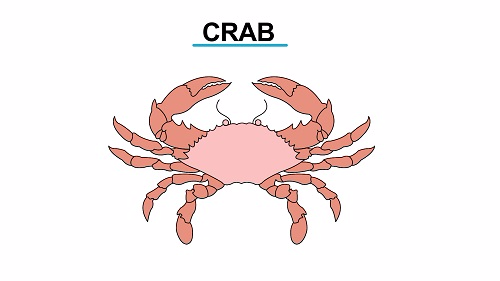
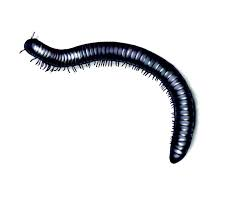
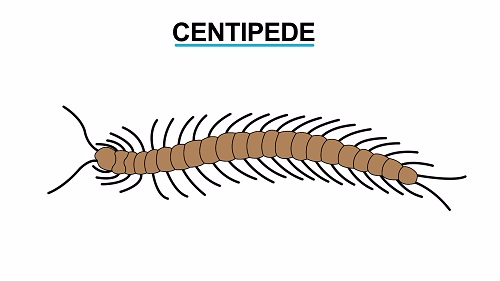
The Advantages and Disadvantages of the Organisms under each Class of Phylum Arthropoda
Explain the advantages and disadvantages of the organisms under each class of phylum arthropoda
IMPORTANCE OF CRUSTACEANS
- Human beings use crustaceans as food especially lobsters, shrimps, crabs and crayfish
- Some of them are used for decorations in the homes especially crabs and crayfish
- Most crustaceans attract tourists during their visits especially along the beaches
IMPORTANCE OF THE CLASS DIPLOPODA
- The millipedes can be useful like earthworms; they help to aerate the soil
IMPORTANCE OF INSECTS
- Most insects are naturally useful in pollination e.g. bees and flies
- Other insects e.g. bees are able to make various substances like honey and wax that are consumed by humans and wax is used for making candles
- Some insects like termites and earthworms help to turn the soil over and so keep it lose and aerated
- Most insects are vectors of several species of disease causing organisms e.g. mosquito is the vector for plasmodium that causes malaria in humans. Flies are vectors for filarial worms that cause river blindness in humans
DISADVANTAGES OF INSECTS
- Many insects transmit diseases to people by transmitting contaminated material by means of their appendages e.g. houseflies transmit cholera by carrying contaminated stool to whatever can be consumed by human beings.
IMPORTANCE OF ARTHROPODA
- They cause damage to crops and forestry, locusts and some larvae e.g. feed on crops
- They spread diseases to humans and other domestic animals e.g. female anopheles spreads malaria, while tsetse flies spread sleeping sickness
- They are source of food e.g. green grasshoppers, termites, crabs and shrimps
- They cause damage to household materials e.g. cockroaches damage furniture
- Some members aid pollination e.g. bees, butterflies and lady birds
Phylum Chordata
Phylum chordata is found in the kingom Animalia. Members found on phylum chordata are fish, frog, lizard, birds, rats etc.
General and Distinctive Characteristics Features of the Phylum Chordata
Explain general and distinctive characteristics features of the phylum chordata
General Distinctive Characteristics of Phylum Chordata are:
- They have a notochord in the embryonic stage. If they notochord persists throughout the life span, it may be surrounded by a vertebral column as in lungfish or it may both be surrounded by a vertebral column as in some chordata
- Their nerve cord is hollow and placed dorsally to the gut
- They have gill slits at least during the embryonic stage
- They have tail which is behind the anus
Classes of the Phylum Chordate
Mention classes of the phylum chordate
The phylum chordata consists of six classes which are
- Class Chondrichthyes
- Class Osteichthyes
- Class Amphibia
- Class Reptilia
- Class Aves and
- Class Mammalia
Distinctive Features of Each Class of the Phylum Chordata
Explain distinctive features of each class of the phylum chordata
Distinctive features of Class Chondrichthyes
- The skeleton is made up of cartilage
- The body is covered with placoid scales
- The caudal fin has tow lobes that differ in size
- Each pair of gills is in a separate compartment
- The mouth and two nostrils are ventrally placed
- Males have Copulatory structures called claspers
Distinctive Features of Class Osteichthyes
- The skeleton is made up of bones
- The body is covered with ganoid scales
- The mouth is terminally placed and nostrils are forced on the dorsal surface
- All pairs of gills are found in common chamber and the chambers are covered by an operculum
- The caudal fin has loves of the same size
Distinctive Features of Class Amphibia
- Their skin is always moist example frogs
- Their life cycle involves larva form called tadpole
- They have gills which are present in the early stages of the development of the tadpole
- They have a heart which has three chambers
- There is gaseous exchange by gills in the tadpole and in the adult it takes place in the lungs, skin and the mouth lining
Distinctive features of Birds
- The body is covered with feathers
- The anterior pair of limbs is modified into wings
- The mouth is modified into a beak or bill
Distinctive features of Class Mammalia
- Their body is covered with hairs
- They have mammary glands
- They have teeth of different types and shapes
- They have diaphragm
- Their red blood cells have no nucleus
- They have sweat glands. The body temperature of mammals is constant
Structure of Representative Organisms in each Class of Phylum Chordata
Describe structure of representative organisms in each class of phylum chordata
Structure of Amphibians
The body of toad or frog consists of a head and trunk only. The skin is dry and warty in toads and smooth and shiny in frogs. On the head are pair of nostrils and lower eyelids, which are almost immovable.
The fore limbs of toads and frogs are short. They have 4 digits on each hand, as the thumb is missing. The hind limbs are much longer than the front ones and the feet are very large. A thin web of skin, which is particularly well developed in frogs, joins the toes. Adult toads are mainly land animals and usually enter water only to breed.
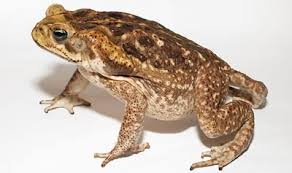
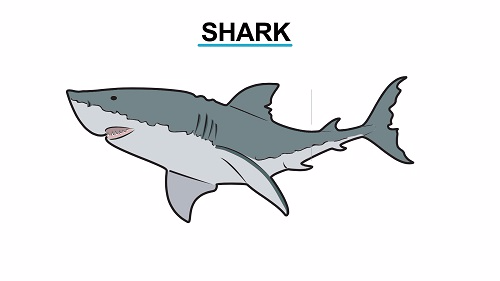
Example of Specimen found on Class Chondrichthyes

Example of Specimen found on Class Chondrichthyes
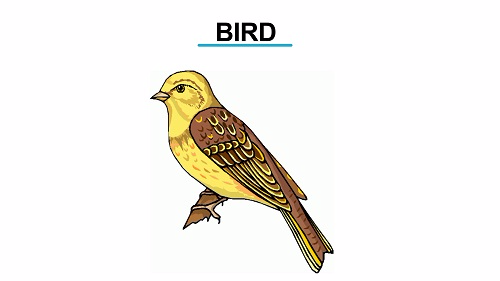
Example of Specimen found on Class Aves

Example of Specimen found on Class Mammalia
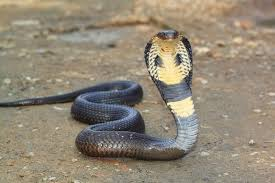
Example of Specimen found on Class Reptilia
The advantages and disadvantages of Organisms under each Class of Phylum Chordata
Outline the advantages and disadvantages of organisms under each class of phylum chordata
Importance of Amphibians
- They are ecologically important
- They are used in research specimen
- Some amphibians are eaten as food
- Some amphibians have unique features. Example abnormally big sizes attract tourists
- They have typical characteristics of larger animals hence they are among the most preferred specimens for biological studies
Importance of Class Reptilia
- Reptiles act as attractive features e.g. colour of snake
- Reptiles are used as a source of food for other species example birds feed on snakes
- Reptiles are used in decorations in houses
Disadvantages of Class Reptilia
- Can cause death to human beings, for example a snake
Importance of Birds
- Flesh of several species is used as food for human beings example chicken, duck
- The feathers of birds are used for decorations
- Birds are also used for the pollination of seeds and fruit dispersal
- Some birds like Ostriches are attractive to tourists
- Some species of birds are used for biological control
Importance of Mammals
- Most mammals serve as source of food for human beings example cows, sheeps
- Mammals help in production of manure example manure from cows, goats
- The bones of mammals are used for production of animal charcoal
- Most wild animals in national parks and game reserves attract tourists
- Some domestic mammals such as cows and donkeys are trained to perform human duties such as cultivation of crops





thanks
ReplyDelete